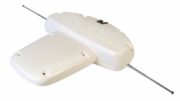The first TV antenna probably went on a home sometime around 1940. By 1960, pretty much every home had one. They were a common new home accessory well into the 1970s. And back then, without the advanced manufacturing we have today, TV antennas were large, bulky, and sturdy. That means that millions of homes probably still have TV antennas on them. If you’ve recently moved into one, you’re in luck — a world of free TV awaits you. If that antenna is in good shape and is still wired into the house, chances are it will work as well or better for you than it ever has.
As you learn more about antennas, you will realize that the proper way to aim an antenna is to point it toward the source of the broadcasts. Usually this is a major city. But what if you look up on the roof and find that antenna’s aimed 90 degrees away from a major city? You may look at other old antennas in your neighborhood and find the same thing. What’s going on here? The answer is simple.
Let’s talk about multipath interference
Multipath interference was a common problem with older antennas. It’s still a common problem today, but digital amplifiers often filter it out effectively. Simply put, multipath interference happens when the same signal comes to your TV from two different directions. The signal could take a direct path from the towers, and another strong signal could bounce off a hill, mountain, or even a large building. When both signals come to your TV at different times, there can be problems. In the old analog TV days, this tended to mean multiple images on screen, offset from each other. Today you don’t see it that way, but it can still cause problems.
If you want to learn more about multipath interference, I’ve written quite a bit more here.
If you have problems with multipath, one of the easiest ways to deal with it is to aim your antenna a little off axis. This tends to make the weaker signal too weak to receive, and the stronger signal is usually strong enough that it isn’t a problem.
Then there’s the rare case
If you find that your antenna is pointed more than a few degrees off axis, there are two possibilities. The first is that the person who put it up didn’t know what they were doing. Of course this is always possible. But if you hook that antenna up to a TV and it works great, chances are it’s the other possibility: that they did know exactly what they were doing. They found that the signal that bounced off a hill or building was actually stronger than the one they got by pointing direct. This is more common than you think, especially in hilly areas. Because multipath was so much more obvious in older days before digital TV, aiming the antenna properly was so critical. Back then, it was so much harder to get a crystal clear picture. People used whatever technique worked for them.
Should you re-aim your antenna?
If that old antenna on the roof is bringing in all the channels you need, I say leave it alone. On the other hand, if you’re ready to go to something more modern, you can try aiming it the way you think it should be aimed and seeing if you get even more channels. Of course, when shopping for antennas, you really owe it to yourself to check out the great selection at Solid Signal. If you have any questions, be sure to call us at 888-233-7563 during East Coast business hours.





